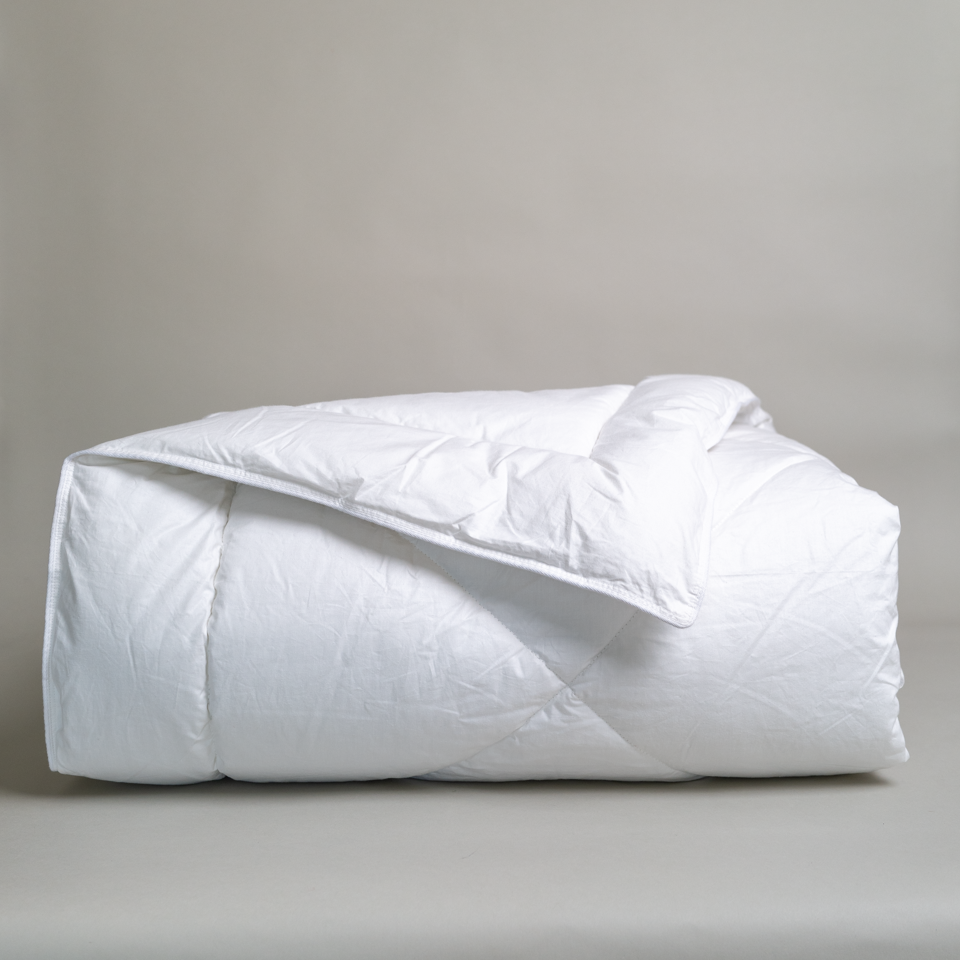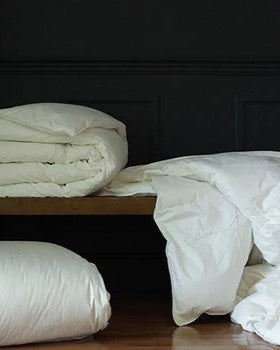Although down comforters can be more expensive than other types of comforters, with proper care, a down product could last you a lifetime, meaning it will save you money over other products that don't exhibit the same durability and require replacement more frequently. Of course, you will have to learn how to clean and care for your comforter appropriately if you want to ensure continued benefits for years to come.
Simple Steps to Care for Your Down Comforter
Once you’ve chosen and purchased your down comforter, you’ll want it to last. Here are some tips that will help you enjoy your down comforter for many years to come.
1. Fluff Your Down Comforter Regularly
Our down comforters are manufactured with 1 ¼” baffle box construction to prevent movement of the down so that it remains evenly distributed throughout the comforter. Nonetheless, the down can seem to settle and flatten over time. It’s best able to fulfill its function of keeping you warm when it’s properly fluffed. Therefore, part of your care routine should be fluffing it every so often. If you keep your comforter on your bed, it's easy enough to fluff by giving it a simple shake. If you store it in a linen closet during seasons when it’s not in use, you'll not only want to air it out but also to allow it several hours to expand after being compressed. Make sure to store your down comforter in a breathable bag rather than an airtight one. This will lessen the chance that moisture in your comforter could lead to mildew.
2. Use a Duvet or Comforter Protector Consistently
The best way to protect your down comforter is by placing it in a protector or cover. This allows you to customize the look of your bed to match your décor. It also makes it easier to keep your comforter clean. It’s much easier to launder the duvet cover than to wash and dry the comforter itself. We recommend you remove the duvet cover weekly to be laundered with the other bed linens.
3. Make Repairs as Necessary Before Laundering
Our down comforters are manufactured with 235-thread-count, 100% preshrunk cotton ticking to retain the fill. We also use German cotton piping to provide strength and durability. Nonetheless, before laundering your down comforter, you should check all seams and look for any thinning spots it may have suffered from detrimental wear and tear. You want to avoid leaving any down fill in your washer or dryer by making any necessary repairs (reinforcing seams, adding patches, etc.) before laundering.
4. Pretreat Stains Before Laundering
Any comforter can become soiled with use. Read the care label on your comforter before washing it to guarantee you maximize the manufacturer’s guidelines. If your comforter has been subjected to spilled food, pets, or accidents, pretreat any stains before you wash to ensure that your comforter comes out spotless. You can accomplish this by using standard stain treatments before washing. We do not recommend bleach as it can damage the down fill and ticking fabric your comforter is covered in over time.
5. Wash Your Down Comforter When It Becomes Soiled or Before Storing
Often, when people think they are allergic to down, it is the dust and dust mites that have accumulated on the down to which they are reacting. You should launder your comforter if there are visible stains or noticeable odors. Even if there are no visible stains or noticeable odors, we recommend laundering every six months or before storing your down comforter.
Our down comforters can be dry cleaned or washed in your home machine, so long as it is large enough to allow movement of the comforter in the drum. Machine wash in cold or warm water on the gentle cycle with a mild detergent. Use only as little detergent as possible. And while you are cleaning your comforter don’t forget to clean your pillows, too!
6. Dry Your Down Comforter Thoroughly
Down comforters can take a lot longer than other types to dry. We recommend tumble drying on low until the comforter is thoroughly dry. Be prepared: it could take several hours to completely dry a down comforter. You cannot allow any moisture to remain because it can lead to mildew, so drying is an important aspect of the cleaning process. We suggest adding wool dryer balls or clean tennis balls to the dryer to help fluff and open up the down. A good way to tell when it's done, even if you can't feel any more dampness, is to give it a sniff. Wet down can smell a little bit like a wet pet, so you'll know when it's dry.
7. Dry Clean If Your Machine at Home Does Not Have the Capacity
If you're nervous about taking proper care of your down (or other) comforter or your washing machine isn't big enough to handle the load, you should think about taking it in for dry cleaning.
8. Store Your Down Comforter Properly
If you store your down products (comforters, pillows, or feather beds) for the season, be sure they are clean and completely dry. Never put them in plastic bags or plastic containers. Down is a natural product—it needs to breathe. If these products are enclosed in a plastic bag with no air holes, moisture can build up and they may begin to smell. Always store down products in appropriate containers in a dry area with proper ventilation. We recommend our storage boxes and zippered bags to protect them from dust or dirt when not in use.
With the right care, you can enjoy your down comforter for a lifetime.
-Team at down etc
Read more:
The Advantages of Sleeping Under a Down Comforter
Why Choose down etc’s Organic-Cotton Covered Comforters?
Your Ultimate Guide to Choosing a New Comforter
How Can Couples Sleep Better? Separate Comforters
Why Summer-Weight Comforters Support Healthy Sleep
About down etc
For over twenty years, down etc has worked with hoteliers and professional housekeepers in hotels around the world to manufacture and provide pillows and bedding that will offer hotel guests memorably great sleep. Through our retail website, we seek to provide products that will result in the same quality sleep for our customers at home. We believe in the restorative power of a great night’s sleep, whether at home or away. That’s the reason down etc wrote the book on it, Roll Into a Perfectly Made Bed: All You Need to Know About the Art of Bedmaking.
DISCLAIMER: You should not rely on any of the foregoing as a substitute for, nor does it replace, professional medical or health and wellness advice, diagnosis, or treatment by a healthcare professional. If you have specific concerns or a situation in which you require professional or medical advice, you should consult with an appropriately trained and qualified specialist, such as a licensed physician, psychologist, or other health professional. Never disregard the medical advice of a physician, psychologist, or other health professional, or delay in seeking such advice, because of the information or content offered or provided on the Site. The use of the Site and all information and content contained thereon is solely at your own risk.






